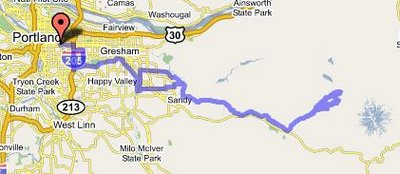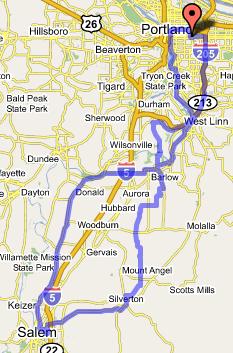6/25/2006 -- Barlow Trail Century, 120 miles
 The Barlow Trail Century is my favorite organized ride. The 2006 edition was the third iteration, and my third time doing it. It's a little on the expensive side, at $35 to pre-register, but it's a fundraiser for Bicycles and Ideas for Kids Empowerment, so the money goes to a good cause. Plus, the food and support is absolutely top-notch, culminating in awesome tasty burritos and local microbrew at the finish line.
The Barlow Trail Century is my favorite organized ride. The 2006 edition was the third iteration, and my third time doing it. It's a little on the expensive side, at $35 to pre-register, but it's a fundraiser for Bicycles and Ideas for Kids Empowerment, so the money goes to a good cause. Plus, the food and support is absolutely top-notch, culminating in awesome tasty burritos and local microbrew at the finish line.It's also kind of a tough ride, with about 7000' of climbing, total, including an ascent up Lolo Pass on the northwest corner of Mt. Hood. But it's a beautiful route that goes the way it does for good reason; I love the Torture 10000, too, but the route kind of tries a little too hard to pack in the elevation at the cost of not really feeling like it's going somewhere. With Barlow, getting to the top of Lolo Pass feels like it's an accomplishment, and the ride out and back feels like an epic -- all of the climbing is for an ultimate purpose, none is gratuitous.
I finally convinced my buddy John Climaldi to join me for the ride this year. John and I are an excellent team for brevets and fast recreational rides, we're fairly well matched, strengthwise, and we ride similar platforms (John on a Carbon Aero, me on a Ti Aero). He's also good company for the long haul. Also, I knew he'd get a kick out of the course and scenery.
I rode from my house to the start at Paesano Park, and met John. We made some last-minute bike adjustments, and promptly hit the road. Actually, bike path. The route starts out on the Springwater Corridor, and goes to the end of the pavement, just outside Boring. Then it gets on some secondary country roads to Dodge Park Boulevard. There was a slight amendment to the route this year, so I ended up leading JC somewhat off the path to a gas station on Orient Road which had been on the route in previous years. (Just as well, as I needed to find a restroom.)
We followed Dodge Park Boulevard to Lusted Road, and took that down through the wooded switchbacks to the Sandy River, and then up the other side. We were at the first rest stop at Bull Run School in no time, and we met up with fellow OHPV'ers Joe Keenan and Marilyn Hayward. We chatted for a little while, and then pressed on. The day was really heating up, and we wanted to get some climbing out of the way before the sun got too high.
Out of Bull Run, we got on Shipley, which was a gently climbing, winding road with plenty of shade from the surrounding alder trees. When Shipley ended, we turned onto Marmot Road, which took us along a ridge called the Devil's Backbone, so named by pioneers who hauled their wagons up the ridge after taking the Barlow Road across the mountain. The top of the ridge included fir forests and horse pastures, and gave us occasional glimpses of the mountain.
After rolling along the top for a couple miles, the road plummeted down through the trees and before we knew it we were out in a clear alpine valley, threading our way between hay fields, with the mountain rising above the hills in front of us. Little Switzerland. I started singing "The hills are alive with the sound of muuuussiiiic" in my campiest falsetto.
A few miles later, we entered the dry pumice-y forest of pines and firs to the north of the Sandy River, in the area around Brightwood. Here, the Barlow Road blessed us with almost brand new, smooth pavement, as it gradually climbed up the valley past the occasional vacation cottage. Before we knew it, John and I were at Lolo Pass Road, ready to start the day's big climb.
There was another rest stop there, though, so we took advantage. We loaded up on fresh fruit and berries, grabbed a cookie or two, and refilled our water. Then we began the big push up to the pass.
The climb up to Lolo Pass is on a small, twisty forest service road that switches back and forth, winding along the edge of the hillside. The grade varies greatly, going from 5% on up to 15% or so for short stretches. Fortunately for us on that hot day, it was almost entirely shaded. I left John behind because I wanted to see what kind of shape I was in, to really test myself against that climb, whereas John took a more relaxed approach to it.
 We met again at rest stop at the top of the pass, where it was pretty much a party. There was all kinds of great food, from the traditional fresh fruit and breads to ravioli and italian sausage. There was also a beautiful view of the peak from the pass, and John and I got our picture taken.
We met again at rest stop at the top of the pass, where it was pretty much a party. There was all kinds of great food, from the traditional fresh fruit and breads to ravioli and italian sausage. There was also a beautiful view of the peak from the pass, and John and I got our picture taken.It was really heating up by that point, though, so after resting and refueling, we got rolling, looking forward to the 12 mile descent off of the pass that was in front of us. The road down is different from the road up, and much better suited to a high-speed descent. It was a white-knuckler, and the Aero handled it like a champ. Though I made a couple questionable judgements, and had to feather the brakes a bit when I went into a couple of the corners a little too hot.
We regrouped at the junction with Barlow Road, and then sailed along back down that sweetly paved road at 26 mph while hardly breaking a sweat. The route is mostly out-and-back, which gave us the same scenery from a new perspective, but it was so nice the first time that we weren't at all unhappy to get it again. We started climbing again at Little Switzerland, and then there were a couple steep pitches as we scaled the Backbone from the opposite direction. The heat was in full force by that point, and I think John and I were really feeling it. But the rollers at the top went by easily enough, and then we were sailing back down towards Bull Run. We stopped briefly when John got a flat, and I realized just how much I craved speed when the sweat on my body stopped evaporating quite so quickly.
We watered up at Bull Run, and then went down the to river, up the other side, and wound through the country east of Boring. At that point, my strength was somewhat down, and I was in my "keep pedaling" mode. But in Boring, a sweet couple was giving out popsicles from a roadside awning. Oh MAN! Talk about hitting the spot on a hot day! That little frozen chunk of fructose was plenty to refresh us and power us back the rest of the way to Paesano, and then home.
This is a great ride in and of itself, and the organized version definitely adds a lot of value over just riding it on your own (but that is fun, too). But another great aspect of it is that it is a wonderful way to get onto Mt. Hood without having to ride on Highway 26. Furthermore, once the Barlow Road ends, and you find yourself near Zig Zag on Lolo Pass Road, there are a number of really nice campgrounds that very easily accessible. This is a very reasonable (though somewhat challenging) ~60 mile ride from east Portland -- well within what most touring cyclists are comfortable doing in a day.
Here's a link to the map of the route on gmaps.













